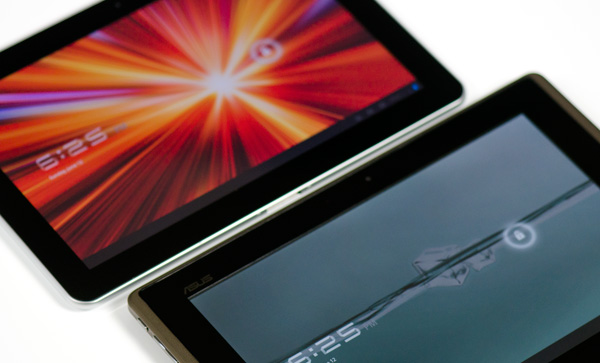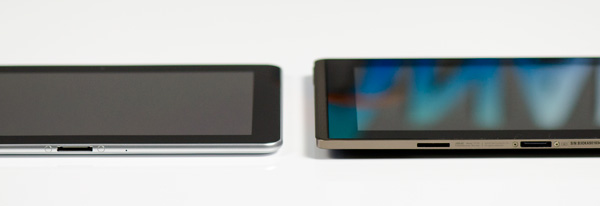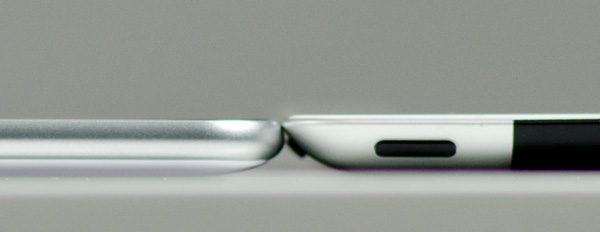Samsung Galaxy Tab 10.1 Review: The Sleekest Honeycomb Tablet
by Anand Lal Shimpi on June 13, 2011 5:07 AM EST- Posted in
- Tablets
- Samsung
- Tegra 2
- Galaxy tab 10.1
- Android 3.1
- Mobile
- NVIDIA
I remember standing in the audience of Samsung's CTIA press conference as it announced, for the first time ever, pricing and availability of its unreleased Galaxy Tab 10.1 and 8.9 before shipping. The smartphone (and early tablet) industries have gone this long without having to really compete based on price, mostly because in North America the carriers subsidize much of the cost. If every device costs $199 under contract, why get carried away with details like how much it actually costs?
The Galaxy Tab however was playing in a different space. While Apple ultimately caved to the pressures of carrier subsidies with the iPhone, the iPad remains completely unsubsidized and its followers buy it by the millions. The magical price point is $499 and it was at Samsung's CTIA press conference that it announced it would be matching Apple's $499 price point, and even dropping slightly below it for the 8.9-inch version.
At the time it seemed like a bold move, enough to give Honeycomb the fighting chance it needed. The Galaxy Tab would be thinner and lighter than the iPad 2 but competitively priced as well. This wouldn't be another Xoom.

Samsung Galaxy Tab 10.1 (top) vs. ASUS Eee Pad Transformer (bottom)
Then ASUS showed up. At $399, the Eee Pad Transformer not only offered a different usage model to the iPad and Galaxy Tab, it brought a lower price tag as well. Availability has been slim thanks to component shortages, but with the Eee Pad selling for $399 the Galaxy Tab at $499 all of the sudden seems overpriced.
| 2011 Tablet Comparison | ||||||
| Apple iPad 2 | ASUS Eee Pad Transformer | Motorola Xoom WiFi | Samsung Galaxy Tab 10.1 | |||
| SoC | Apple A5 (Dual ARM Cortex A9 @ 1GHz) | NVIDIA Tegra 2 (Dual ARM Cortex A9 @ 1GHz) | NVIDIA Tegra 2 (Dual ARM Cortex A9 @ 1GHz) | NVIDIA Tegra 2 (Dual ARM Cortex A9 @ 1GHz) | ||
| GPU | PowerVR SGX 543MP2 | NVIDIA GeForce | NVIDIA GeForce | NVIDIA GeForce | ||
| RAM | 512MB | 1GB | 1GB | 1GB | ||
| Display | 1024 x 768 IPS | 1280 x 800 IPS | 1280 x 800 | 1280 x 800 PLS | ||
| NAND | 16GB | 16GB | 32GB | 16GB | ||
| Dimensions | 241.2mm x 185.7mm x 8.8mm | 271mm x 175mm x 12.95mm | 249.1mm x 167.8mm x 12.9mm | 256.6 x 172.9 x 8.6mm | ||
| Weight | 601g | 695g | 730g | 565g | ||
| Price | $499 | $399 | $599 | $499 | ||
Based on specs alone you'd be right. Samsung's Galaxy Tab 10.1 has the same NVIDIA Tegra 2 tablet SoC inside,
1GB of LPDDR2 and 16GB of NAND on-board. You get a 10.1-inch 1280 x 800 PLS display and 802.11n WiFi support. It's worth pointing out that we're now well into the month of June and NVIDIA continues to be the only SoC vendor shipping in Honeycomb tablets. Samsung originally had plans to ship its own Exynos SoC in the Galaxy Tab but Tegra 2 remains the port of choice for all Honeycomb vendors at this point. Whether or not NVIDIA can win twice in a row with Ice Cream Sandwich later this year remains to be seen.

Samsung Galaxy Tab 10.1 (left) vs. ASUS Eee Pad Transformer (Right)
Where Samsung gives you something more for your money is in build quality and form factor. While Eee Pad Transformer feels surprisingly good for a cost reduced tablet, it doesn't feel nearly as slim or portable as the Galaxy Tab 10.1. It's no wonder Samsung went back to the drawing board on this one, the result is something that in many ways feels better than the iPad 2.
Apple still gets the nod in terms of quality of materials. The aluminum back of the iPad 2 is unbeatable. The Galaxy Tab 10.1 however feels lighter, a bit more rugged (I'm less concerned about scratching plastic than I am marring aluminum) and a little more comfortable to hold as a result. Against the Eee Pad there's no competition. I can live with the Eee Pad, but I much prefer the feel of the Galaxy Tab 10.1. The new Tab just feels like a device from this year - a compliment that, until now, I had only given to Apple.
The Galaxy Tab 10.1 measures just 8.6mm thick, 0.2mm thinner than the iPad 2. To be honest you really can't tell the difference, both devices feel thin. Ever after holding them back to back it's near impossible to tell that Samsung has built a thinner device. The most tangible difference in feel is the weight, not just in overall mass but in terms of weight distribution. The Galaxy Tab seems to carry the weight a bit better than the iPad, a bit more evenly.

Samsung Galaxy Tab 10.1 (left) vs. Apple iPad 2 (right)
Now is as good a time as any to point out that although Samsung calls this the Galaxy Tab 10.1, it's really the new Galaxy Tab 10.1. Originally Samsung announced a much thicker version at Mobile World Congress, a month prior to the CTIA announcement. With the much thinner iPad 2 hitting the market after the original 10.1 announcement, Samsung scrapped plans for the original and unveiled the thinner 8.6mm version as the new Galaxy Tab. The original Galaxy Tab 10.1 is now known as the Galaxy Tab 10.1v.












108 Comments
View All Comments
darkhawk1980 - Monday, June 13, 2011 - link
One thing that might be of note to those buying, might be the fact that the secure software key (SSK) for the Asus Transformer has in fact been found. This means that it is now possible to completely unlock the device to do whatever you'd like with it (ie possibly install Ubuntu Linux?). This is something that I'd be surprised if it happened with the Samsung Tab 10.1. While for most people it probably doesn't make a huge difference, but in another month the ability to have both Honeycomb and Ubuntu on the device could be a very compelling argument.Personally, given how much Samsung locks down their devices, I would never buy into their tablets. I still believe the Asus provides a much better overall experience. While it isn't the lightest, nor is it the most thin, it provides the best experience and flexibility. And to be perfectly honest, the price is pretty damn good as well. Having a rooted Asus and being able to overclock it a bit (1.6 GHz and really stable) makes a pretty decent difference in performance.
BTW, I've always wondered, how much of a difference does the resolution difference between the IPad 2 and all other Honeycomb tablets make a difference in the graphical benchmarking tools? I would imagine it does make a decent difference, all things given.
My experience with tablets thus far (have spent a few hours looking at the Acer Iconia and Samsung/Xoom at Best Buy, and bought a Transformer) is that I really do enjoy having it. I like being able to pick it up and browse the web while watching TV during commercials or boring parts of a show. I love reading books and comic books on it. And to be perfectly honest, since I got Plants vs. Zombies the other day for free from Amazon, I use it way too much. More than my wife I think.....
adt6247 - Monday, June 13, 2011 - link
Samsung locking down devices? You on crack? All of the Galaxy S devices shipped with unlocked boot loaders. Samsung also just sent a few Galaxy S II phones to the CyanogenMod team that brought CM7 to the various GSM Galaxy S variants. I rooted my Captivate within an hour of purchase, and I got it on launch day. How much less locked down do you want?My biggest complaint with Samsung was TouchWiz, and that simply isn't an issue here.
ph00ny - Monday, June 13, 2011 - link
That's what i was about to say. Only company active leaving the bootloader unlockedmongo lloyd - Monday, June 13, 2011 - link
Reports have said that Samsung will deliver its TouchWiz UI enhancements in a later update.You can see a very recent video of how it looks on the 8.9 here: http://www.youtube.com/watch?v=yj7M1WTiwGo
StormyParis - Monday, June 13, 2011 - link
to see the insta-obsolescence of those things. Each month brings a new tablet that's da schinitz... for a month. And now Tegra 3 will arrive within a couple of months, and the OEMs that kind messed up first time around (Motorola, a lot; Asus, a bit) will have a second shot at leading the field... Any tablet will be upstaged within 6 tot 12 months anyway, which really is a pain because the new ones will be significantly better (and the current ones are barely "good enough", and those things are a lot more expensive than subsidized phones.I started out waiting for any Android tablet. The first ones, especially the Xoom, where pretty awful, so that morphed into waiting for the eeePad... which is OK, but not as good as the Galaxy. Now I'm thinking 10" is too big. It won't fit into my man-purse and is a bit unwieldy... but the 7-8" alternatives are pretty niche and/or lackluster.
So, in the end, I'm thinking I'll get a cheap Chinese knock-off, test out the format (for web surfing, ebooks, comics, and some videos), and wait 12-24 months for the dust to settle. I've found 8 inchers around 100 USD with 1280x800 and 1024x600 screens (Ainol Novo 8, Zenithink E98)
JasonInofuentes - Monday, June 13, 2011 - link
That's not a terrible plan but try not to be too disheartened. This is simply the expected process of performance increasing with technology advancements played forward really fast. Ten years ago when deciding what computer to buy you would have asked yourself a few questions that had to do with features; at the time they would have involved playing the latest games, fast internet access, expandability and sufficient storage. So, a Radeon 9700, an ethernet NIC, a decent case, a 40 GB drive and a Pentium IV and you were all set. A few years ago you would have added HD video playback, WiFI and turned all the other dials up a few notches. And that's basically where we are today. Ten years ago to meet the demands of most users you needed a pretty high end system, anything less and the compromises were pretty high. Today, a decent video card (nothing integrated, yet), a cheap mobo with all the bells and whistles integrated, a cheap 2TB drive, and Intels cheapest Pentium will probably hit all your feature requests and still fit in a case smaller than the box my 9700 came in.In tablet talk, we are, thankfully, a bit beyond the Pentium IV era, but we're not quite at Penryn, and still a few years off from Nehalem. You can play games, you can watch HD video and you can do all the other things you want to do, you just can't do it as smoothly as you might want, and certainly not so smoothly as you could on your netbook. But we're in the post-PC era, so the days will come.
If I were you, still expecting to wait as much as two years before really committing to the cause, I'd hold off on that Chinese grey market special, pick-up a used Nook Color and throw CM7 on it. It's not Honeycomb but it's not bad either. And when you decide the market is ready for you to throw some real money on a tablet it'll be like booting up a Sandy Bridge powered MacBook Pro after years of using a Powerbook G4. Let us know how it goes!
StormyParis - Monday, June 13, 2011 - link
I'd go for the nook color in a blink if I could get it. I'm in France though, and don't know anyone in the US. Even my brother in Canada can't et it, as far as I can tell.jrs77 - Monday, June 13, 2011 - link
First of all, nice review there Anand.The Galaxy Tab 10.1 looks really good actually and with the bigger resolution then the iPad2 it's more to my liking. However, Android still doesn't feel as good as iOS and that's the real downside of the iPad-competition currently. With a pricetag of the iPad2 I'd take the better OS and go with Apple still, as I don't mind about the iTunes-thingy actually for a device that's primarily ment to browse the web or watch movies while travelling from/to work every day.
I'd like to see a tablet with a fully suported USB-port, that let's me use a internet-stick or external storage, with a pricetag of a netbook ($400). That would really be a step forward actually.
tayb - Monday, June 13, 2011 - link
Still sucks. I'm sorry, but it does. It's half baked and crashes more than a Microsoft Windows beta. It's not a finished product and I'm starting to understand how Google seems to make such rapid improvements to their OS. It's because they release the beta as the full version and then fix all of the massive holes and bugs with new OS releases.I still don't see a tablet offering from any company that I would actually be interested in. $499 for this is not a great deal unless you compare it to the iPad. Hey, the iPad is overpriced. I can walk into any electronics store and get a powerful notebook for $499.
ph00ny - Monday, June 13, 2011 - link
Have you tried 3.1 honeycomb tablets over 3.0? It looks like they're progressing very nicely